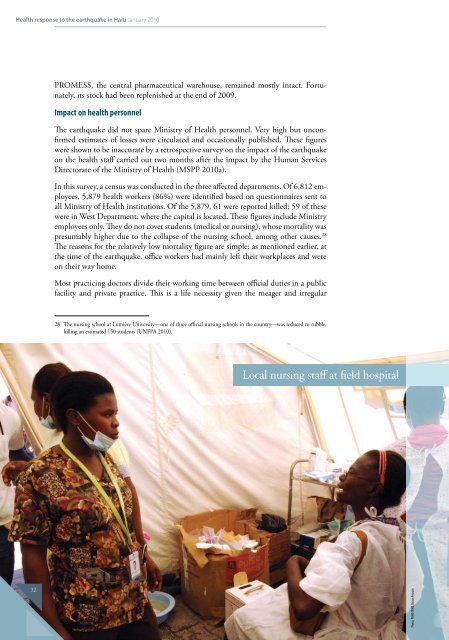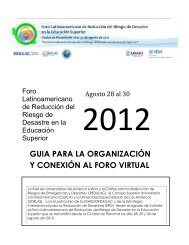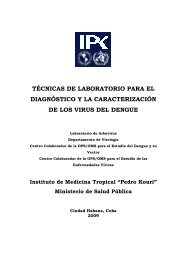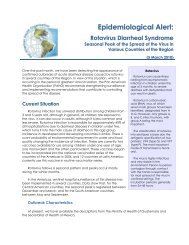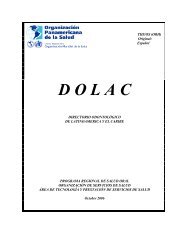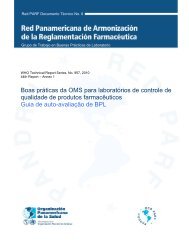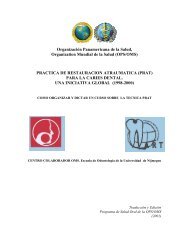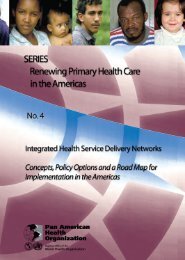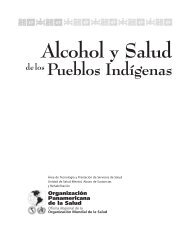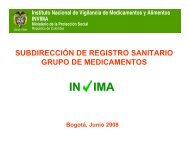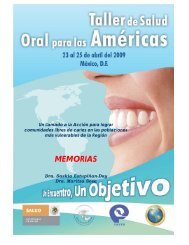Health response to the earthquake in Haiti, January 2010
Health response to the earthquake in Haiti, January 2010
Health response to the earthquake in Haiti, January 2010
- No tags were found...
Create successful ePaper yourself
Turn your PDF publications into a flip-book with our unique Google optimized e-Paper software.
<strong>Health</strong> <strong>response</strong> <strong>to</strong> <strong>the</strong> <strong>earthquake</strong> <strong>in</strong> <strong>Haiti</strong> <strong>January</strong> <strong>2010</strong>PROMESS, <strong>the</strong> central pharmaceutical warehouse, rema<strong>in</strong>ed mostly <strong>in</strong>tact. Fortunately,its s<strong>to</strong>ck had been replenished at <strong>the</strong> end of 2009.Impact on health personnelThe <strong>earthquake</strong> did not spare M<strong>in</strong>istry of <strong>Health</strong> personnel. Very high but unconfirmedestimates of losses were circulated and occasionally published. These figureswere shown <strong>to</strong> be <strong>in</strong>accurate by a retrospective survey on <strong>the</strong> impact of <strong>the</strong> <strong>earthquake</strong>on <strong>the</strong> health staff carried out two months after <strong>the</strong> impact by <strong>the</strong> Human ServicesDirec<strong>to</strong>rate of <strong>the</strong> M<strong>in</strong>istry of <strong>Health</strong> (MSPP <strong>2010</strong>a).In this survey, a census was conducted <strong>in</strong> <strong>the</strong> three affected departments. Of 6,812 employees,5,879 health workers (86%) were identified based on questionnaires sent <strong>to</strong>all M<strong>in</strong>istry of <strong>Health</strong> <strong>in</strong>stitutions. Of <strong>the</strong> 5,879, 61 were reported killed; 59 of <strong>the</strong>sewere <strong>in</strong> West Department, where <strong>the</strong> capital is located. These figures <strong>in</strong>clude M<strong>in</strong>istryemployees only. They do not cover students (medical or nurs<strong>in</strong>g), whose mortality waspresumably higher due <strong>to</strong> <strong>the</strong> collapse of <strong>the</strong> nurs<strong>in</strong>g school, among o<strong>the</strong>r causes. 28The reasons for <strong>the</strong> relatively low mortality figure are simple: as mentioned earlier, at<strong>the</strong> time of <strong>the</strong> <strong>earthquake</strong>, office workers had ma<strong>in</strong>ly left <strong>the</strong>ir workplaces and wereon <strong>the</strong>ir way home.Most practic<strong>in</strong>g doc<strong>to</strong>rs divide <strong>the</strong>ir work<strong>in</strong>g time between official duties <strong>in</strong> a publicfacility and private practice. This is a life necessity given <strong>the</strong> meager and irregular28 The nurs<strong>in</strong>g school at Lumière University—one of three official nurs<strong>in</strong>g schools <strong>in</strong> <strong>the</strong> country—was reduced <strong>to</strong> rubble,kill<strong>in</strong>g an estimated 150 students (UNFPA <strong>2010</strong>).Local nurs<strong>in</strong>g staff at field hospital32Pho<strong>to</strong>: PAHO/WHO, Vic<strong>to</strong>r Arisca<strong>in</strong>


